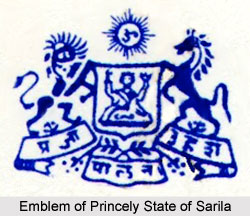 The Princely State of Sarila was a princely state under the indirect control of the British administration. It covered a total area of 35.28 sq miles and comprised of a total population of 7,250 in the year 1941. Sarila state was a part of Central India Agency in Bundelkhand Agency. The princely state was located in Bundelkhand and included 9 separate villages in the year 1941. The small state was bordered by the district of Hamirpur of the British United Provinces of Agra and Oudh. It lied between Charkhari in the south and Beri in the north. Sarila was primarily a non-Salute state.
The Princely State of Sarila was a princely state under the indirect control of the British administration. It covered a total area of 35.28 sq miles and comprised of a total population of 7,250 in the year 1941. Sarila state was a part of Central India Agency in Bundelkhand Agency. The princely state was located in Bundelkhand and included 9 separate villages in the year 1941. The small state was bordered by the district of Hamirpur of the British United Provinces of Agra and Oudh. It lied between Charkhari in the south and Beri in the north. Sarila was primarily a non-Salute state.
The Bundela Rajputs, who descended from the 2nd son of Chhatrasal of Panna named Jagat Raj, were the ruling family of the princely state of Sarila. Tej Singh, the successor of Man Singh, was evicted by Ali Bahadur of Banda, but was later restored to portions of his lands through support of Himmat Bahadur. After the region came under the dominion of the British East India Company, Tej Singh possessed only the Sarila fort and village of Sarila. Later in 1807, he was granted 11 villages.
A council was established which was in charge of the administration of the state. The native ruler or the Raja enjoyed full criminal and civil jurisdiction and took charge of the administration of the state. As a result of the support provided by the Raja of Sarila during the Great Revolt of 1857, the British Government of India abolished the obligation of the state to pay relief or nazarana to its overlord on each succession in the year 1862. Sarila State was one of the original constituent members of the Chamber of Princes, a number of smaller states indirectly represented by 12 princes who were elected periodically.
This article is a stub. You may enrich it by adding more information to it. You can send your write-up at content@indianetzone.com



















